Pheasants are one of the few game birds that belong in the family Phasianidae. Due to their large size and brightly colored feathers, these gallinaceous birds are often confused with peacocks, but they are totally two different birds.
Historically speaking, pheasants have a long history that can be traced back as far as 2000 years and they have been in the United States for more than 200 years.
Pheasants were first brought into the United States in 1773, but they weren’t bred and commercialized until the early 1800s. More pheasants were imported from English game bird farms in the late 1800s and 1900s, causing their population to increase.
Fast forward to today, these birds have been introduced into 40 states. One of the pheasant species, the Ring-necked Pheasant has even been named as the state bird of South Dakota.
If you have a deep interest in raising these unique game birds, then you have come to the right place. This article will explain every little thing that you should know about raising pheasants.
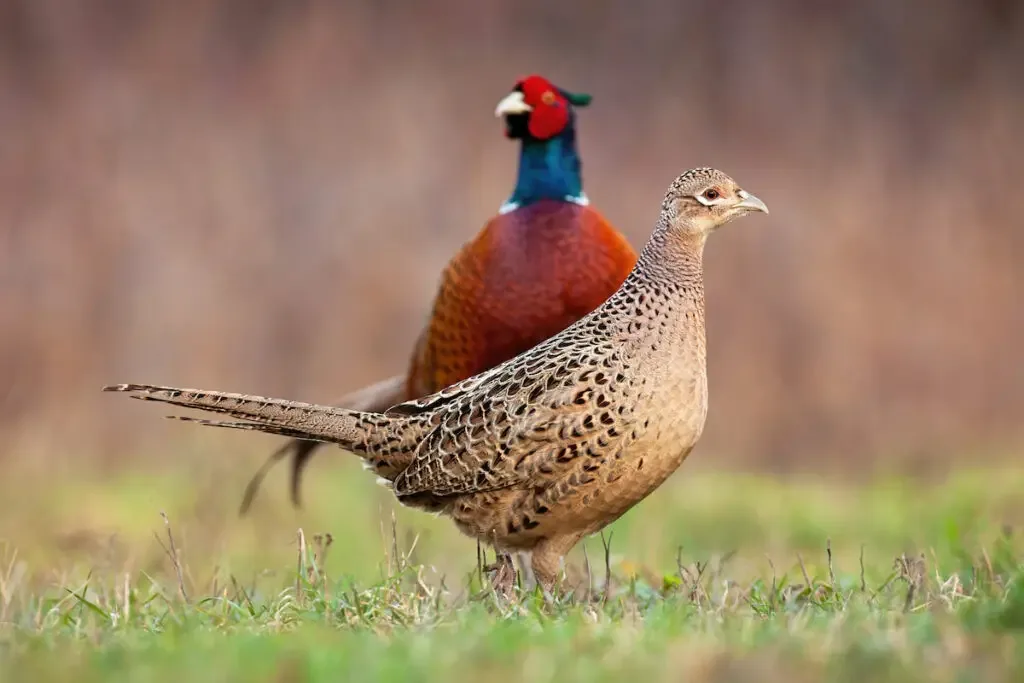
How To Choose The Best Pheasant Breed
Different types of pheasants possess their own physical traits that separate one from another. But their basic necessities of living are generally the same.
Choosing the breed that can thrive best in your region and is easy to handle is quite important. You need to do your own due diligence before making a purchase.
It is estimated that there are around 49 pheasant species that can be found all around the world, but only a select few are suitable to be raised by humans. These include:
1. Common pheasant (Phasianus colchicus)
Common pheasants are also known as Ring-Necked pheasants. They are native to China and Southeast Asia but have been introduced to other regions such as the United States, France, the United Kingdom, and other European countries.
Males can be recognized by their bright blue-green head and white neck rings while females generally have plain buff-brown plumages. These semi-domestic birds weigh around 2.9 pounds and stand 21 to 36 inches tall.
Common pheasants generally stay on the ground and only fly when they have to. Their typical lifespan is between 10 to 20 months.
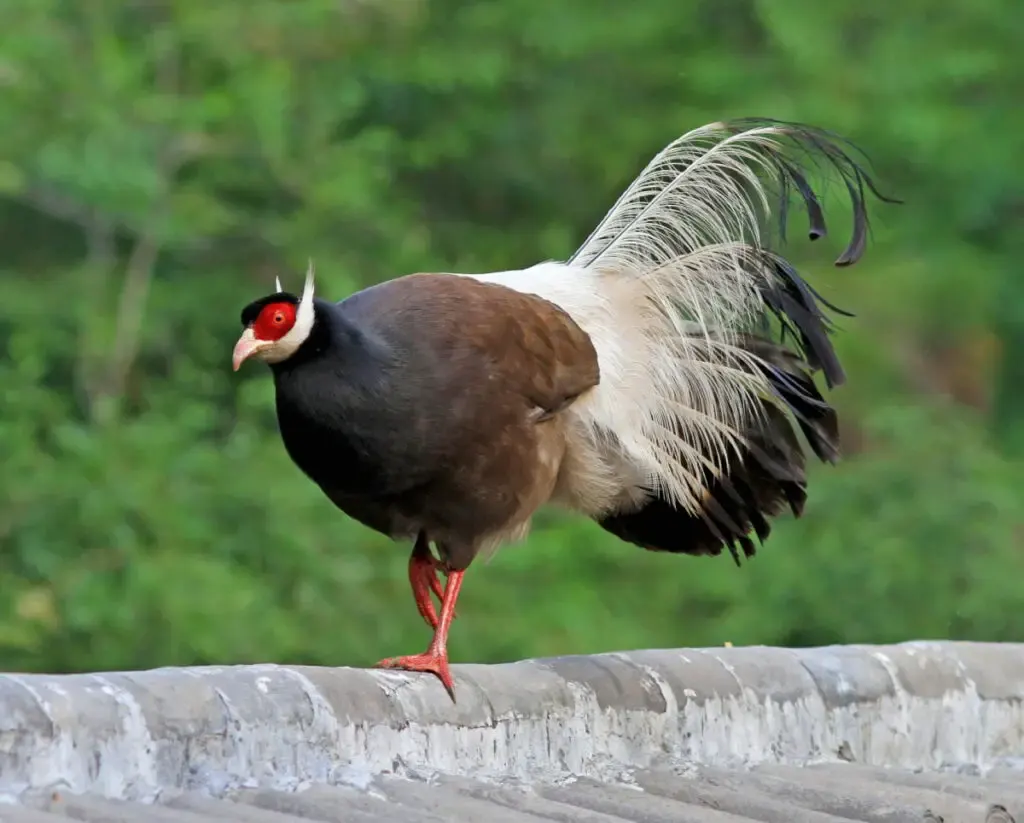
2. Brown-eared pheasant (Crossoptilon mantchuricum)
Brown-eared pheasants can be recognized by their unique bright gray-brown plumage, frosty gray-white rump, and dark tails. They also have bare red faces and legs, dark crowns, and long plumes of white ears.
These pheasants are endemic to mountain forests of China and categorized as Vulnerable on the IUCN Red List of Threatened Species.
Brown-eared pheasants grow up to 39 inches tall and weigh around 5.5 pounds. Males and females are similar except for their body size. Females are slightly smaller than males.
3. Golden pheasant (Chrysolophus pictus)
Also known as the Chinese pheasants or Red Golden pheasant, these birds are native to the mountainous regions in central China and the forests in western China. They have also been introduced to other regions such as the United Kingdom, Florida, Hawaii, and many more.
These small pheasants generally weigh between 1.21 to 1.4 pounds and stand between 24 and 41 inches. Males can be characterized by their golden crests, long tails, and bright plumages that come in different colors such as red, blue, mahogany, purple, and black. Females have slightly dull brown and black plumages with shorter tails.
4. Silver pheasant (Lophura nycthemera)
Silver pheasants originated in the mountain forests and mainland of southern China and southeast Asia (Burma, Cambodia, Thailand, and Vietnam). But they have also been brought to other regions such as Hawaii and other locations in the United States mainland.
Males can be recognized by their white or silvery gray upper feathers, black crests and chests, and long tails. Females possess brownish plumage, black-tipped crests, and shorter tails.
These large pheasants generally stand between 21.7 and 49.2 inches tall and weigh between 2.2 and 4.4 pounds. Both males and females have bare red faces and legs.
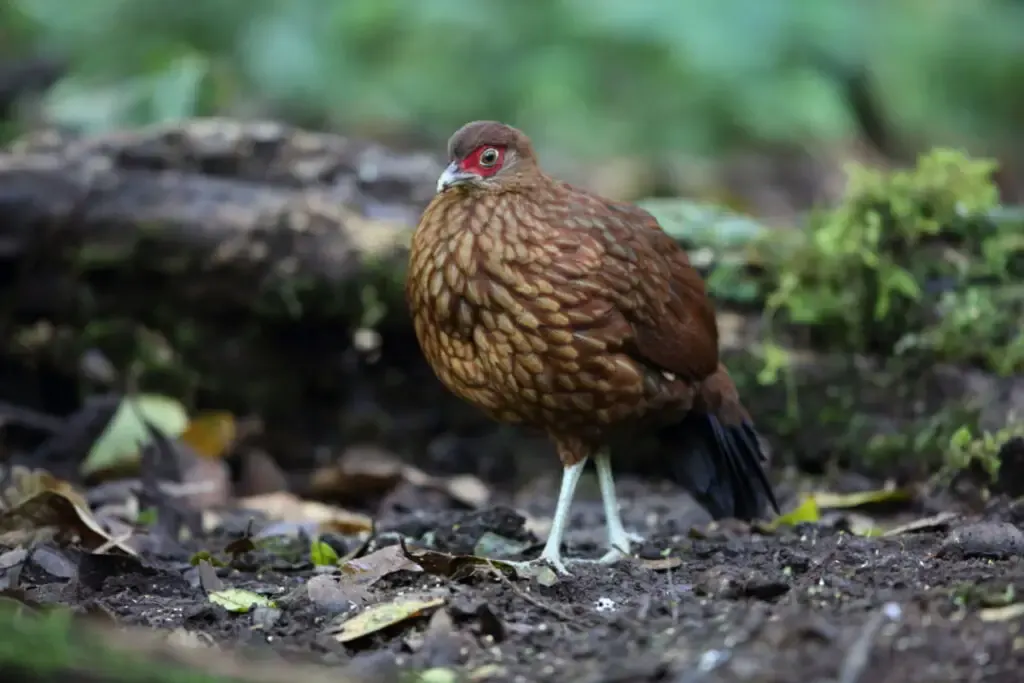
5. Salvadori’s pheasant (Lophura inornata)
Salvadori’s pheasants are also known as the Sumatran pheasants. They are native to the highlands and foothills of Sumatra and regions in Indonesia. In the last few years, their population has slightly decreased due to hunting activities carried out by the locals.
Male Salvadoris’ can be recognized by their dark iridescent blue plumage while females have dull brown bodies with dark tails. Both sexes possess bare red faces, pale bills, white legs, and short tails. They can grow up to 22 inches in body length and weigh between 1.4 and 1.5 pounds.
Salvadori’s pheasants generally look for food quietly on the forest ground and they can be seen in pairs, if not alone.
6. Mikado pheasant (Syrmaticus mikado)
These beautiful pheasants are native to mountainous regions in Central Taiwan. They have also been crowned as the country’s national bird and been drawn onto the Taiwanese dollar.
Male pheasants can be distinguished by their dark-blue plumage, white markings on their wings and tails, and red wattles. Females have olive-brown bodies with slightly duller red wattles and pale feather edges. They can grow up to 27.5 inches in body length and weigh between 1.3 to 2.6 pounds.
Mikado pheasants generally forage for food on grassy forest floors, bamboo growth, dense shrubs, and in the undergrowth of montane forests.
7. Siamese Fireback pheasant (Lophura diardi)
These endemic birds are also known as Diard’s Fireback pheasants. Siamese Fireback pheasants are native to lowlands forests of Southeast Asia, typically in Thailand, northern Vietnam, Cambodia, and Laos. Siamese Fireback pheasants are also available in most aviculture in the United States.
Males can be recognized by their blue-gray plumage, red face, yellow bills, red feet and legs, and glossy black tails. Females possess brown plumage, red patches on the face, dark gray bills, red feet and legs, and black-and-white banded wings. They can grow up to 31 inches in body length and weigh between 1.5 to 2.3 pounds.
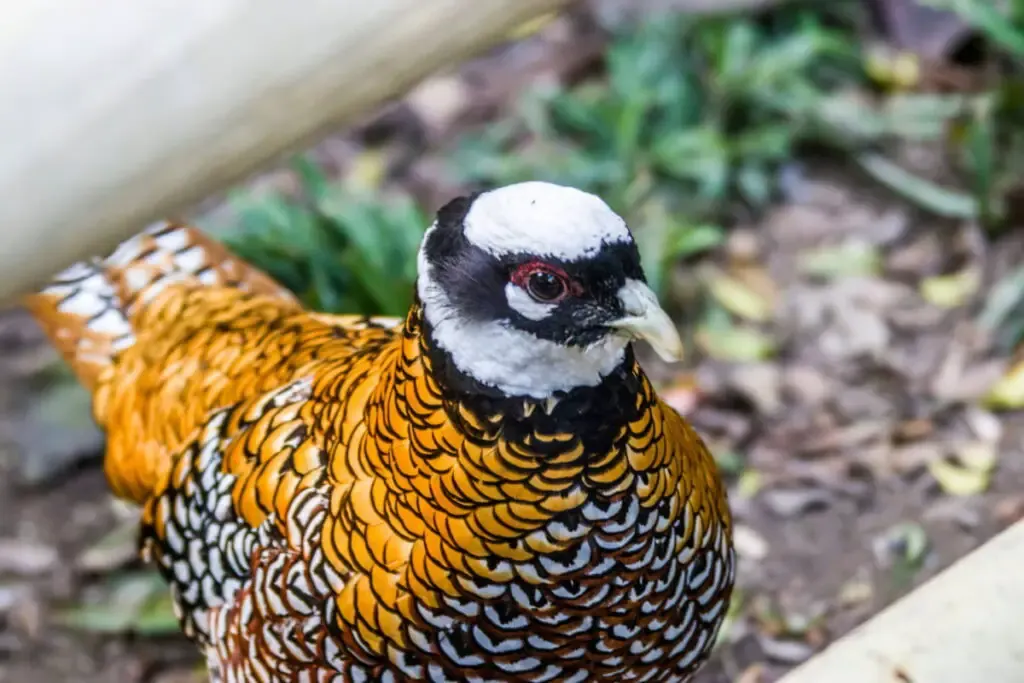
8. Reeves’s pheasant (Syrmaticus reevesii)
These large pheasants are native to Central and Eastern China. But they also have been introduced to other parts of the world including the United States, France, Czech Republic, United Kingdom, and other regions in Europe. These birds were named after a British biologist, John Reeves, who brought these birds to Europe in 1831.
Reeves’s pheasants can grow up to 82 inches in body length with a wingspan of 21 to 35 inches. Male pheasants can be recognized by their golden feathers, red patches around the eyes, brown iris, grey legs, and long silvery, white-brown tails.
Female Reeves’s pheasants are slightly smaller than males with brown feathers, dark crowns, buff face, and grey-brown tails.
These birds are hardy and their call consists of a musical warble.
9. Copper pheasant (Syrmaticus soemmerringii)
Copper pheasants are endemic to mountainous forests and hills of the Japanese islands such as Kyushu, Shikoku, and Honshu.
These birds grow up to 53.5 inches in length and weigh between 2 and 3 pounds. Male pheasants can be recognized by their coppery brown plumage, red patches of skin around the eyes, and long banded tail. Female pheasants possess gray-brown upper feathers and buff barred dark down parts. Males’ tails are much longer than females’.
The population of copper pheasants has decreased in the last few years due to excessive hunting, predation, and other gaming activities. However, regulations and preventive measures have been taken by local authorities.
10. Lady Amherst’s pheasant (Chrysolophus amherstiae)
These colorful pheasants are native to China and have been introduced into the wild regions in southern England. They were named after Sarah Countess Amherst, wife of the Governor General of Bengal William Pitt Amherst, who brought the first bird of this breed back to London in 1828.
Lady Amherst’s pheasants can grow to 43.3 inches in length and weigh between 1.5 and 2 pounds. Male pheasants can be recognized by their red, blue, white, and yellow bodies, black and silver heads, long striped tails, and black-and-white scaling on their necks. Females are slightly different with black stripes on their brown plumage and gray skin around the eyes.
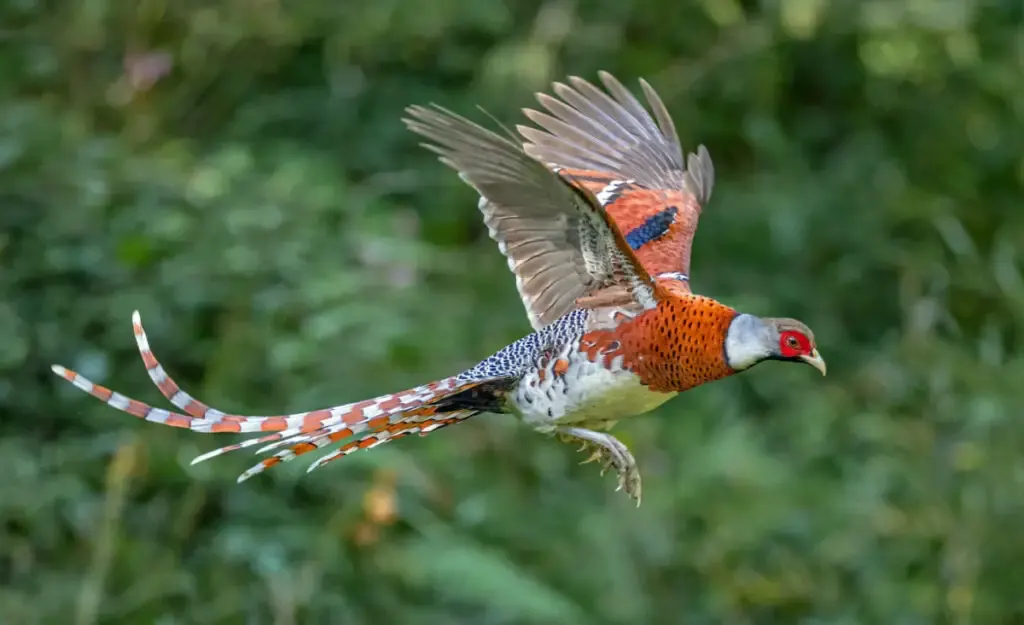
11. Elliot’s pheasant (Syrmaticus ellioti)
Elliot’s pheasants are endemic to the thick and mountainous forests of southeast China. They were named after an American ornithologist, Daniel Giraud Elliot, who was one of the founders of the American Ornithologists Union.
These pheasants can grow up to 31 inches in length and weigh between 2.2 and 3.1 pounds. Male pheasants can be recognized by their brown upper feathers, silver heads, white bellies, bright red face, and long pale gray tails. Female pheasants possess similar colors but are slightly duller with much shorter tails.
Elliot’s pheasants are categorized as an endangered species due to excessive hunting and habitat loss.
12. Cheer pheasant (Catreus wallichi)
Cheer pheasants are also known as the Wallich’s pheasants, which is the name of a Danish botanist, Nathaniel Wallich. These pheasants are native to the highlands and scrublands of western Himalayas, from northern Pakistan, through Kashmir, east to central Nepal, and other regions in India.
Male pheasants can be distinguished by their pale, black-and-white plumage, rust-colored lower backs, dark bellies, and thick black bands on the tail.
On the other hand, female pheasants possess brown plumage with white streaks all over their bodies, black spots on the chest, and rust-colored belly. Cheer pheasants grow between 2.3 and 3.9 feet in length and weigh around 1.9 to 3.9 pounds.
Their calls are very loud and can be heard from a mile away.
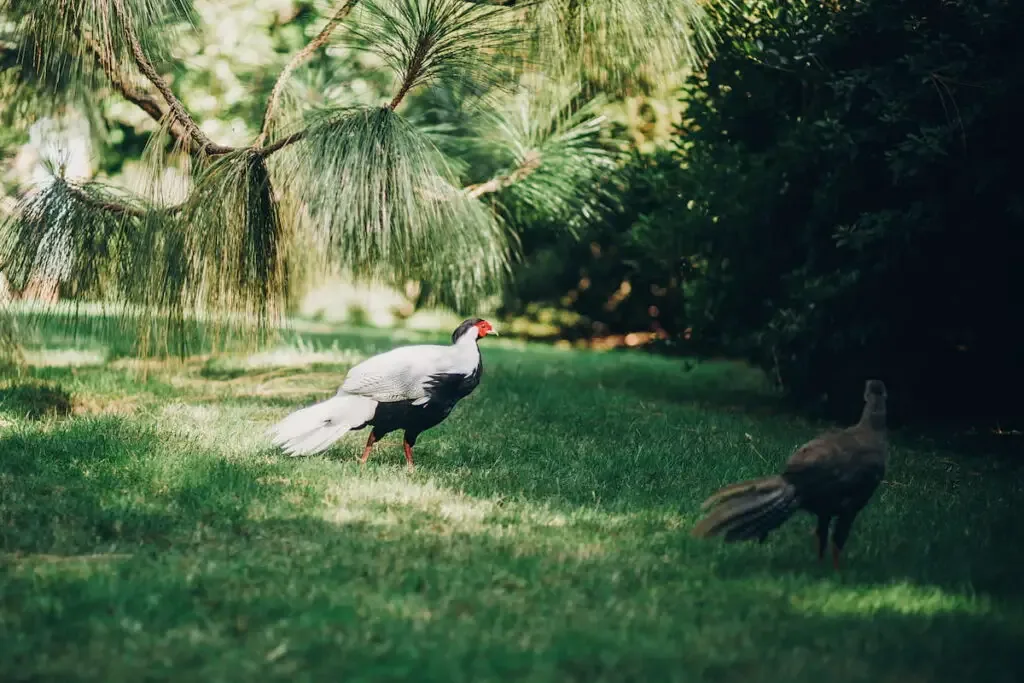
How To Build Pheasant Housing
Out in the wild, pheasants love to roam on the forest floors, lowlands, and open fields on a day-to-day basis. However, if you keep them domestically, they need the best of both worlds: an open field and a shelter.
Pheasant housing is quite important, especially in sheltering these birds from changing weather and all the elements. There are a few things to consider when you plan to build pheasant housing. These include:
Coop size and space
Pheasants need adequate space to move freely and sleep without being too close to one another. This is why coop size matters in relation to their body size.
As a general rule of thumb, you should provide these birds with at least 10 to 12 square feet of space per adult bird. The overall size of the coop should be around 200 to 300 square feet in size. This is to avoid overcrowding issues that can cause fights, lethargy, and even cannibalism.
Different ages of pheasants require different amounts of space to live. For instance:
| Pheasant Age | Size (Square feet) |
| 1 – 2 weeks | 25 |
| 3 to 6 weeks | 1 |
| 6 to 12 weeks | 4 |
However, when pheasants have matured, different breeds might require different floor space due to their overall body length and height that varies from one another.
This table shows some of the space requirements for other pheasant breeds:
| Breeds | Aviary Size (Square feet/Square meter) |
| Common pheasant | 200 sq ft/19 sq m |
| Brown-eared pheasant | 200+ sq ft/19+ sq m |
| Golden pheasant | 100 sq ft/9.3 sq m |
| Silver pheasant | 100 – 200 sq ft/9.3 – 18.6 sq m |
| Salvadori’s pheasant | 150 – 200 sq ft/14 – 18.6 sq m |
| Mikado pheasant | 200 sq ft/18.6 sq m |
| Siamese Fireback pheasant | 150 – 200/14 – 18.5 sq m |
| Reeves’s pheasant | 200+ sq ft/19+ sq m |
| Copper pheasant | 200 sq ft/18.6 sq m |
| Lady Amherst’s pheasant | 100+ sq ft/9.3+ sq m |
| Elliot’s pheasant | 200 sq ft/18.6 sq m |
| Cheer pheasant | 200 sq ft/18.6 sq m |
Housing materials
When constructing pheasant shelters, choosing good materials is important to ensure that their coop will last for a long time. The most basic but strong material is wood.
Wooden coops are easy to set up, cost-effective, and able to withstand different types of climates.
It is also easier for you to create additional airways for ventilation when keeping pheasants in wooden coops.
Depending on your budget, there are two types of floorings that you can use for pheasant coops: concrete and wooden floorings. Each material will serve different purposes and needs.
For instance, a concrete floor is easy to clean but costs more than a wooden floor. A wooden floor is also easy to clean and cheap but may rot over a long period of time.
Whichever flooring you choose, be sure to choose the one that is tailored to your needs, budget, and the surrounding environment. Avoid using dirt as flooring. Although it is the cheapest option, dirt can be easily penetrated by burrowing animals such as rats and raccoons.
Additional structure
There are other additional structures that you can build in and around your pheasant housing. For instance:
Wire fences
Fencing helps in deterring predators while preventing your pheasants from escaping. You can use poultry netting or galvanized wire gauze and plant them around the coop. Be sure to pull the netting tight to prevent any gaps or pockets that could allow your pheasants to escape or worse, get stuck in them.
Then, bury wooden or concrete posts at the end of each netting to add more support to the structure.
Heat source
An additional source of heat is important, especially for brooding chicks and during a long cold season. You can install heat lamps with reflectors or a gas hover.
Be sure to account for the distance between the heat lamps and the floor to avoid burning and overheating issues.
Sand boxes
Sandboxes can be used to disinfect pheasants from dirt, bacteria, or bugs that might get stuck in between their feathers. You can use a children’s sandbox or builder’s sand mixed with a low concentration of agricultural lime.
Avoid putting sandboxes too close to their feeders to avoid contamination of their feed.
Feeders and waterers
Be sure to regularly clean their feeders and waterers. Dirt and mold build-up can cause serious health issues in pheasants that may require a trip to the vet.
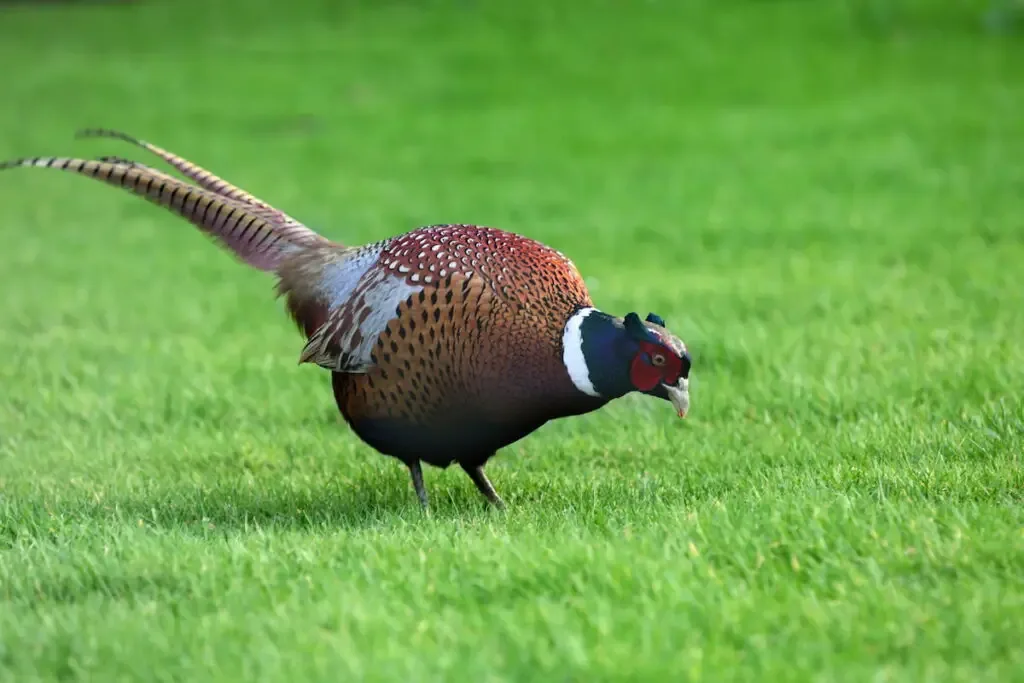
What Should I Feed Pheasants?
Feeding pheasants with the best diet is important to facilitate their growth while maintaining their overall health throughout their life.
Generally speaking, pheasants are omnivores. In their wild habitat, they mostly feed on various food including insects, worms, grains, small plants, fruits, roots, seeds, and many other things that they can forage on the forest floors.
When you keep them in your backyard or farm, you need to make sure that they get the same amount of nutrients as they would receive from their foraging habit. However, their nutrient composition will also vary depending on their ages.
This table shows the minimum amount of nutrients that pheasants need based on their growth stages:
| Nutrients | 0 – 4 weeks (%) | 4 – 9 weeks (%) | 9 – 16 weeks (%) | Breeders (%) |
| Crude protein | 28.00 | 24.00 | 18.00 | 18.00 |
| Crude fibre | 3.00 | 3.00 | 3.00 | 4.00 |
| Crude fat | 2.50 | 3.00 | 3.00 | 3.00 |
| Calcium | 1.10 | 1.00 | 0.87 | 3.00 |
| Sodium | 0.20 | 0.20 | 0.20 | 0.20 |
| Phosphorus | 0.65 | 0.65 | 0.61 | 0.54 |
| Cystine | 0.46 | 0.36 | 0.28 | 0.30 |
| Lysine | 1.77 | 1.31 | 0.93 | 1.04 |
| Methionine | 0.56 | 0.47 | 0.36 | 0.38 |
| Calorie/protein ratio | 99.00 | 119.00 | 166.00 | 153.00 |
| Metabolize energy megajoules | 11.64 | 11.97 | 12.52 | 11.51 |
As a general rule of thumb, chicks between 0 and 3 weeks should be fed with a starter feed that contains 29% protein. Once they have reached more than 3 to 7 weeks, you can switch to feed with 26% protein. After they have grown past 7 to 24 weeks, it is time to feed with grower feed that contains 20% protein. For adult pheasants, regular feed with 14% protein is enough to provide them with the amount of nutrients that they need.
Pheasants also need a constant supply of fresh water to wash down their feed while preventing dehydration, especially during the hot season. So, be sure to check for the amount and condition of their water frequently.
Finally, don’t forget to supplement their diet with other food that contains essential vitamins, minerals, and insoluble grit for better digestion. These include oats, wheat, chaffed lettuce, rye, berries, cowpeas, millets, corns, and other plants.
Here are some of the vitamins that pheasants need in their diet:
| Nutrients | Growers | Feeders | |
| Vitamin A (acetate form) | mg/kg | 2400 | 2750 |
| Vitamin B2 | mg/kg | 7.5 | 7.5 |
| Vitamin D3 | mg/kg | 50 | 50 |
| Vitamin E | mg/kg | 11 | 33 |
| Vitamin K | mg/kg | 2 | 2 |
| Vitamin B12 | mg/kg | 11 | 11 |
| Zinc | ppm | 65 | 65 |
| Copper | ppm | 5 | 5 |
| Iodine | ppm | 1 | 1 |
| Manganese | ppm | 100 | 100 |
| Niacin | mg/kg | 70 | 80 |
| Biotin | mg/kg | 45 | – |
| Folic acid | mg/kg | 0.33 | – |
| Pantothenic acid | mg/kg | 16 | 16 |
| Choline chloride | mg/kg | 1550 | 1450 |
Health And Disease Management
Pheasants are considered hardy birds and are usually not affected by common diseases. They can live 15 to 25 years, which is quite a long time for any game bird. However, this doesn’t mean they are totally invulnerable to certain avian illnesses.
Here are some diseases that can affect pheasants, be it individually or the whole flock:
- Aspergillosis
- Ataxia
- Avian influenza
- Blastocysts
- Blackhead disease
- Bumble foot
- Coccidiosis
- Corona nephrosis
- Fowl pox
- Worms
- Gape worms
- Egg peritonitis
- Erysipelas
- Mycotoxins
- Marble spleen disease
- Yolk sac infection
- Trichomonas
- Tuberculosis
- Rickets
- Pasteurella
If your pheasants are affected by any of these diseases, seeking professional help would be your best course of action. Once you’ve treated and eradicated the source of the disease, there are a few things that you can do to maintain prevent the outbreak of diseases from happening again.
You can schedule regular sanitation, cleaning their pen and coop frequently, changing their water and feed when you notice any signs of mold and mildew, and hiring a veterinarian for a yearly check-up on every bird in the flock.
Final Thoughts
Like any other game bird, raising pheasants comes with a lot of perks and benefits, provided that they receive all their essential needs.
Although they flourish and thrive in the wild, there is no reason that they can’t thrive in your backyard and farm.
During your first year or two, different challenges might arise but when they are fully mature, these birds are able to live without much supervision. In fact, they will enjoy their freedom as much as any other animal!
Citations
- https://meyerhatchery.zendesk.com/hc/en-us/articles/360034721091-Raising-Pheasants-101
- http://www.oakwoodgamefarm.com/game-raising-tips/
- https://petkeen.com/types-of-pheasants/
- https://putakputak.com/poultry/pheasants/top-10-most-beautiful-pheasants-in-the-world/
- https://www.beautyofbirds.com/housingpheasants.html
- https://discover.hubpages.com/animals/Raising-Pheasants-Build-a-Pheasant-Coop-House
- https://animals.mom.com/how-to-build-pheasant-pens-8524481.html
- https://www.dpi.nsw.gov.au/animals-and-livestock/poultry-and-birds/species/pheasant-raising/feeding-pheasants
- https://stdavids-gamebirds.co.uk/resources/diseases/pheasant-partridge/

